
|
You entered: Perseids
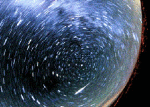 Orionids Meteor Shower to Peak Tonight
Orionids Meteor Shower to Peak Tonight
21.10.1996
Tonight you might be able to see Halley's Comet again - or at least some pieces of it. It is widely thought that that the meteors from the Orionids meteor shower, which peaks tonight, are just small pieces of Halley's Comet falling to Earth.
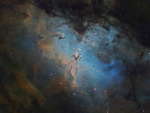 M16 Close Up
M16 Close Up
9.08.2019
A star cluster around 2 million years young surrounded by natal clouds of dust and glowing gas, M16 is also known as The Eagle Nebula. This beautifully detailed image of the region adopts the colorful Hubble palette and includes cosmic sculptures made famous in Hubble Space Telescope close-ups of the starforming complex.
 Polaris: The North Star
Polaris: The North Star
6.10.1999
Polaris is quite an unusual star. First, Polaris is the nearest bright star to the north spin axis of the Earth. Therefore, as the Earth turns, stars appear to rotate around Polaris, making it the North Star.
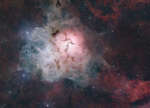 The Light, Dark, and Dusty Trifid
The Light, Dark, and Dusty Trifid
9.08.2024
Messier 20, popularly known as the Trifid Nebula, lies about 5,000 light-years away toward the nebula rich constellation Sagittarius. A star forming region in the plane of our galaxy, the Trifid does illustrate...
 Meteor Over Crater Lake
Meteor Over Crater Lake
25.04.2012
Did you see it? One of the more common questions during a meteor shower occurs because the time it takes for a meteor to flash is typically less than the time it takes for a head to turn.
 Mysterious Green Patches on the Sky
Mysterious Green Patches on the Sky
30.09.2013
What is it? Some surely natural phenomenon has appeared in a video that, so far, has defied clear identification. The above time-lapse video was made to record Perseid meteors above Hopewell Rocks in New Brunswick, Canada late this summer.
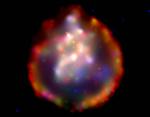 SNR 0103 72.6: Oxygen Supply
SNR 0103 72.6: Oxygen Supply
13.08.2005
A supernova explosion, a massive star's inevitable and spectacular demise, blasts back into space debris enriched in the heavy elements forged in its stellar core. Incorporated into future stars and planets, these are the elements ultimately necessary for life. Seen here in a false-color x-ray image, supernova remnant SNR 0103-72
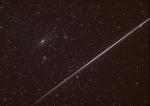 Island Universe, Cosmic Sand
Island Universe, Cosmic Sand
23.08.2002
On August 13, while counting Perseid meteors under dark, early morning Arizona skies, Rick Scott set out to photograph their fleeting but fiery trails. The equipment he used included a telephoto lens and fast color film. After 21 pictures he'd caught only two meteors, but luckily this was one of them.
 Churning Clouds on Jupiter
Churning Clouds on Jupiter
10.08.2020
Where is Jupiter's ammonia? Gaseous ammonia was expected to be seen in Jupiter's upper atmosphere by the orbiting Juno spacecraft -- but in many clouds is almost absent. Recent Juno data, however, gives some clues: some high-level clouds appear to be home to an unexpected type of electrical discharge dubbed shallow lightning.
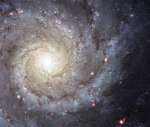 M74: The Perfect Spiral
M74: The Perfect Spiral
11.08.2013
If not perfect, then this spiral galaxy is at least one of the most photogenic. An island universe of about 100 billion stars, 32 million light-years away toward the constellation Pisces, M74 presents a gorgeous face-on view.
|
January February March April May June July |
|||||||||||||||||||||||||||||||||||||||||||||||||